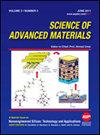Study on Adsorption of Phosphate in Water Environment by Mg–Al Modified Biochar
IF 0.9
4区 材料科学
引用次数: 1
Abstract
Excessive release of phosphate has gained prominence as a pivotal contributor to water contamination. Biochar, known for its abundant surface acreage and unparalleled adsorptive prowess, has been widely employed in aqueous remediation. Within the scope of this investigation, unprocessed biochar was derived from Chaetomorpha valida via pyrolysis methodologies involving temperatures ranging from 320 °C, 460 °C, 620 °C, and 860 °C, respectively. Mg-BC620, Al-BC620, and Mg–Al-BC620 were prepared using the co-precipitation method at the optimal temperature to maximize the resource utilization of Chaetomorpha valida. The physicochemical attributes of altered biochars were evaluated employing X-ray diffractometry and other analytical techniques. The influence of different factors on phosphate’s adsorptive aptitude of altered biochar was investigated, and the adsorptive behavior and mechanism of biochar were studied using diverse kinetics of adsorption and assortment of isotherm models. The outcomes revealed that the optimal pyrolysis temperature was 620 °C, and the altered biochar displayed a strikingly elevated affinity for phosphate sorption, outperforming the unaltered biochar. Among the modified biochars, Mg–Al-BC620 outperformed the rest, boasting an astonishing eradication rate of 94.92% when dosed at 8 g/L, maintaining a pH equilibrium of 7 in the solution, while confronting an inceptive phosphate density of 150 mg/L. The utmost threshold of adsorption proficiency predicted by the Langmuir equation was 228.130 mg/g, which was 88.56 times that of BC620. This modified biochar exhibits a strong affinity for phosphate and excellent adsorption selectivity, providing a promising avenue for the resource utilization of Chaetomorpha valida and has broad application prospects for scavenging phosphate in aqueous mediums.镁铝改性生物炭对水环境中磷酸盐的吸附研究
磷酸盐的过量释放已成为造成水污染的关键因素。生物炭以其丰富的表面积和无与伦比的吸附能力而闻名,已被广泛用于水修复。在本研究范围内,未经处理的生物炭是通过热解方法从裂壳藻中提取的,热解温度分别为320°C、460°C、620°C和860°C。采用共沉淀法,在最佳温度下制备了Mg-BC620、Al-BC620和Mg–Al-BC620,以最大限度地提高黄颡鱼的资源利用率。采用X射线衍射法和其他分析技术对改性生物炭的物理化学性质进行了评估。研究了不同因素对改性生物炭对磷酸盐吸附能力的影响,并利用不同的吸附动力学和等温线模型对生物炭的吸附行为和机理进行了研究。结果表明,最佳热解温度为620°C,改变后的生物炭对磷酸盐吸附的亲和力显著提高,优于未改变的生物炭。在改性生物炭中,Mg–Al-BC620的表现优于其他生物炭,在8 g/L的剂量下,其根除率达到94.92%,在溶液中保持7的pH平衡,同时面临150 Mg/L的初始磷酸盐密度。Langmuir方程预测的最大吸附能力阈值为228.130mg/g,是BC620的88.56倍。该改性生物炭对磷酸盐具有很强的亲和力和优异的吸附选择性,为有效链藻的资源化利用提供了一条很有前途的途径,在水介质中清除磷酸盐具有广阔的应用前景。
本文章由计算机程序翻译,如有差异,请以英文原文为准。
求助全文
约1分钟内获得全文
求助全文
来源期刊

Science of Advanced Materials
NANOSCIENCE & NANOTECHNOLOGY-MATERIALS SCIENCE, MULTIDISCIPLINARY
自引率
11.10%
发文量
98
审稿时长
4.4 months
 求助内容:
求助内容: 应助结果提醒方式:
应助结果提醒方式:


